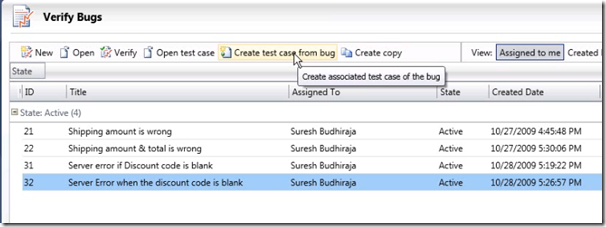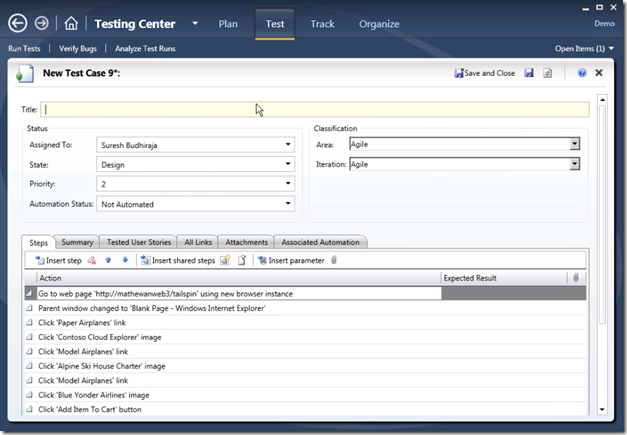Microsoft Test Runner series – part 7 – Exploratory Testing
Hi Again,
So far we have talked about how features & benefits of MTLM when used for the tests that are predefined. E.g. creating actionable bugs, using fast forwarding & so on.
Many times testers test the application in ways that are not predefined (i.e. no fixed flow of steps is prescribed by the author). Some customers feel that this way many new & interesting bugs are found. Bug bashes done by various teams are one of the best ways to find new bugs.
However, there is one pain point that testers feel while performing exploratory tests in this way: it is very hard to remember what they did to cause the bug. Many times the bugs are not reproducible & developers reject the bug as non repro.
When using MTLM, testers can still produce actionable bugs while doing such testing. Here is how:
Create a dummy test case lets’s say “Exploratory test” with one step “Explore the app”. When you load this test in MTR, it shows you the test with one step. Start performing actions on the application as you would while performing any other exploratory test. When you encounter a bug, click on the create a bug & you would have the same actionable bug. i.e. the bug will have all the detailed actions you performed, the video of the recording, system information, intellitrace & any other logs you have configured to collect in test settings. If you had associated any attachments during the test, they are will show up in the bug.
So this time when developer gets a bug, he will be able to get a complete picture of what went in the system that caused the bug.
While creating the bug, you also have the option to select the timeline for which for want the information (e.g. if you want attachments that were added only in last “n” mins of testing, you could do that by choosing to create exploratory bug).
Many times, when a bug is found in this way, testers want to create a test case, so that the issue can be verified later or the test should be added to be part of regular test cycle.
To achieve this MTLM provides a way to make it easy to create a test case using the information in the bug. Choose a bug in MTLM & click on create test case from bug.
A new test case is created & the actions in the action log collected from the bug are converted to the steps. You can edit this newly created test case e.g. delete/add some steps. Name this test case & save it. You have created a new test case to regress the bug easily. The newly created test case is also automatically associated with the bug.
Tip: Some customers even use this functionality to explore the app & then use the steps collected in the action log (from Bug) to create new test cases to start the project.
Whichever way you want to use the functionality, go ahead & explore your app. Happy testing.
Other links:
- Video ALM 7 - Exploratory testing and creating a test case from Bug
Thanks
Suresh Budhiraja
Sr. Program Manager
Comments
- Anonymous
February 13, 2014
Thanks, Very nice explanation. I have question:- When I am performing expletory testing for more than 10 steps and at the end trying to generate test cases, it always generate test cases for last 10 test cases and I want to generate whole test case with all steps I have performed. I m working on functionality which has more than 55 test steps.

